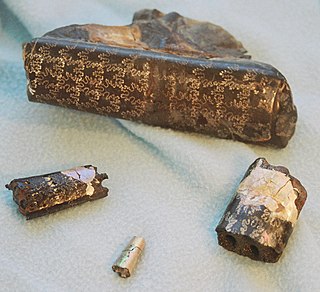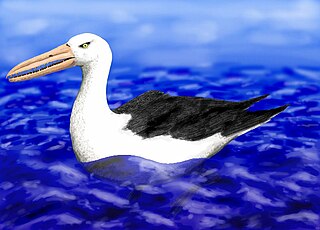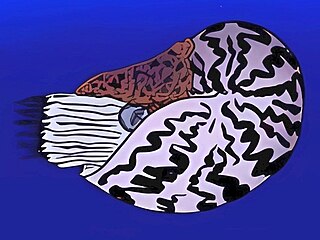
The nautilus is an ancient pelagic marine mollusc of the cephalopod family Nautilidae. The nautilus is the sole extant family of the superfamily Nautilaceae and the suborder Nautilina.

Balaenoptera is a genus of rorquals containing eight extant species. Balaenoptera comprises all but two of the extant species in its family ; the genus is currently polyphyletic, with the two aforementioned species being phylogenetically nested within it.

The Nautilida constitute a large and diverse order of generally coiled nautiloid cephalopods that began in the mid Paleozoic and continues to the present with a single family, the Nautilidae which includes two genera, Nautilus and Allonautilus, with six species. All told, between 22 and 34 families and 165 to 184 genera have been recognised, making this the largest order of the subclass Nautiloidea.

Nautiloids are a group of marine cephalopods (Mollusca) which originated in the Late Cambrian and are represented today by the living Nautilus and Allonautilus. Fossil nautiloids are diverse and species rich, with over 2,500 recorded species. They flourished during the early Paleozoic era, when they constituted the main predatory animals. Early in their evolution, nautiloids developed an extraordinary diversity of shell shapes, including coiled morphologies and giant straight-shelled forms (orthocones). No orthoconic and only a handful of coiled species, the nautiluses, survive to the present day.

Baculites is an extinct genus of heteromorph ammonite cephalopods with almost straight shells. The genus, which lived worldwide throughout most of the Late Cretaceous, and which briefly survived the K-Pg mass extinction event, was named by Lamarck in 1799.

Osteodontornis is an extinct seabird genus. It contains a single named species, Osteodontornis orri, which was described quite exactly one century after the first species of the Pelagornithidae was. O. orri was named after Santa Barbara Museum of Natural History paleontologist Phil C. Orr, for his recognition of the importance of the specimen.

Nautilus is a marine cephalopod genus in the mollusk family Nautilidae. Species in this genus differ significantly, morphologically, from the two nautilus species in the adjacent sister-taxon Allonautilus. The oldest fossils of the genus are known from the Late Eocene Hoko River Formation, in Washington State and from Late-Eocene to Early Oligocene sediments in Kazakhstan. The oldest fossils of the modern species Nautilus pompilius are from Early Pleistocene sediments off the coast of Luzon in the Philippines.

Nautilus cookanus is an extinct species of nautilus. It lived during the Eocene epoch. N. cookanus placed within the genus Nautilus, together with extant species based on their shared shell characters. Fossils of the species from the Late Eocene Hoko River Formation are noted as one of the two oldest occurrences for the genus. Its name has frequently been misspelled as "cookanum".

Nautilus praepompilius is an extinct species of nautilus. It lived from the Late Paleocene through Oligocene epochs. The first fossil specimens discovered in the Late Eocene to Oligocene-aged Chegan Formation of Kazakhstan: an additional, older specimen was found in the Late or Latest Paleocene-aged Pebble Point Formation in Victoria, Australia. N. praepompilius has been grouped into a single genus together with extant species based on their shared shell characters. It is morphologically closest to N. pompilius, hence the name. The nepionic constriction shows that the hatching size was approximately 23 mm, close to that for N. pompilius. N. praepompilius, along with aff. N. cookanum fossils from the late Eocene Hoko River Formation in Washington state are the oldest occurrences of the genus.

The moonfish of the genus Mene, the sole extant genus of the family Menidae, are disk-shaped fish which bear a vague resemblance to gourami, thanks to their thread-like pelvic fins. Today, the genus is represented only by Mene maculata of the Indo-Pacific, where it is a popular food fish, especially in the Philippines, where it is known as bilong-bilong, chabita, hiwas or tahas.
Pseudodontornis is a rather disputed genus of the prehistoric pseudotooth birds. The pseudotooth birds or pelagornithids were probably rather close relatives of either pelicans and storks, or of waterfowl, and are here placed in the order Odontopterygiformes to account for this uncertainty. Up to five species are commonly recognized in this genus.

Aturia is an extinct genus of Paleocene to Miocene nautilids within Aturiidae, a monotypic family, established by Campman in 1857 for Aturia Bronn, 1838, and is included in the superfamily Nautilaceae in Kümmel 1964.

Gryposuchus is an extinct genus of gavialid crocodilian. Fossils have been found from Argentina, Colombia, Venezuela, Brazil and the Peruvian Amazon. The genus existed during the Miocene epoch. One recently described species, G. croizati, grew to an estimated length of 10 metres (33 ft). Gryposuchus is the type genus of the subfamily Gryposuchinae, although a 2018 study indicates that Gryposuchinae and Gryposuchus might be paraphyletic and rather an evolutionary grade towards the gharial.

The Hoko River Formation is a Late Eocene marine sedimentary geologic formation. The formation is exposed in outcrops along the Strait of Juan de Fuca on the Olympic Peninsula in Washington state, USA. It is known for containing numerous fossils of crabs. It overlies the older Lyre Formation and underlies the younger Makah Formation.

Eutrephoceras is an extinct genus of nautilus from the Late Jurassic to the Miocene. They are characterized by a highly rounded involute shell with slightly sinuous suture patterns.

Polymerichthys is an extinct genus of superficially eel-like aulopiform fish known from the late Oligocene to the middle-late Miocene. It contains a single described species, P. nagurai from the Middle Miocene of Japan, though several indeterminate specimens are also known from Russia and Italy.
This list, 2016 in molluscan paleontology, is a list of new taxa of ammonites and other fossil cephalopods, as well as fossil gastropods, bivalves and other molluscs that have been described during the year 2016.
This list 2019 in paleomalacology is a list of new taxa of ammonites and other fossil cephalopods, as well as fossil gastropods, bivalves and other molluscs that are scheduled to be described during the year 2019, as well as other significant discoveries and events related to molluscan paleontology that are scheduled to occur in the year 2019.
This list of fossil molluscs described in 2022 is a list of new taxa of fossil molluscs that were described during the year 2022, as well as other significant discoveries and events related to molluscan paleontology that occurred in 2022.
This list of fossil molluscs described in 2023 is a list of new taxa of fossil molluscs that were described during the year 2023, as well as other significant discoveries and events related to molluscan paleontology that occurred in 2023.














